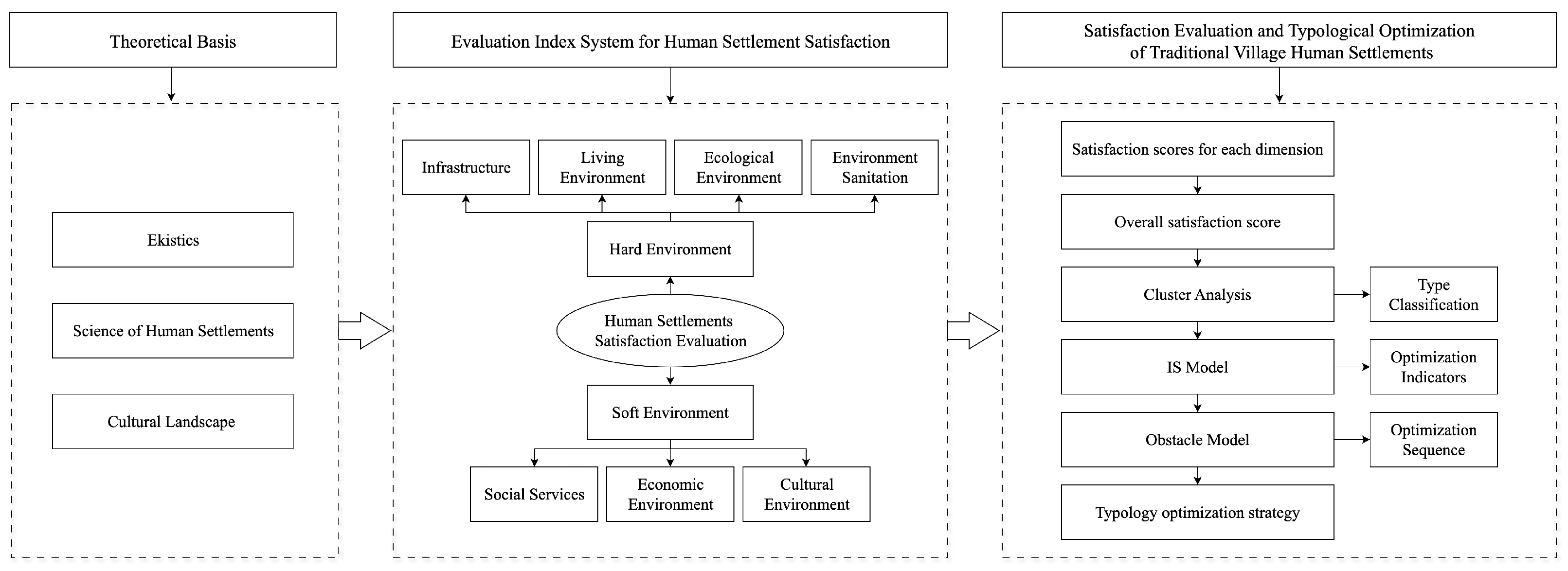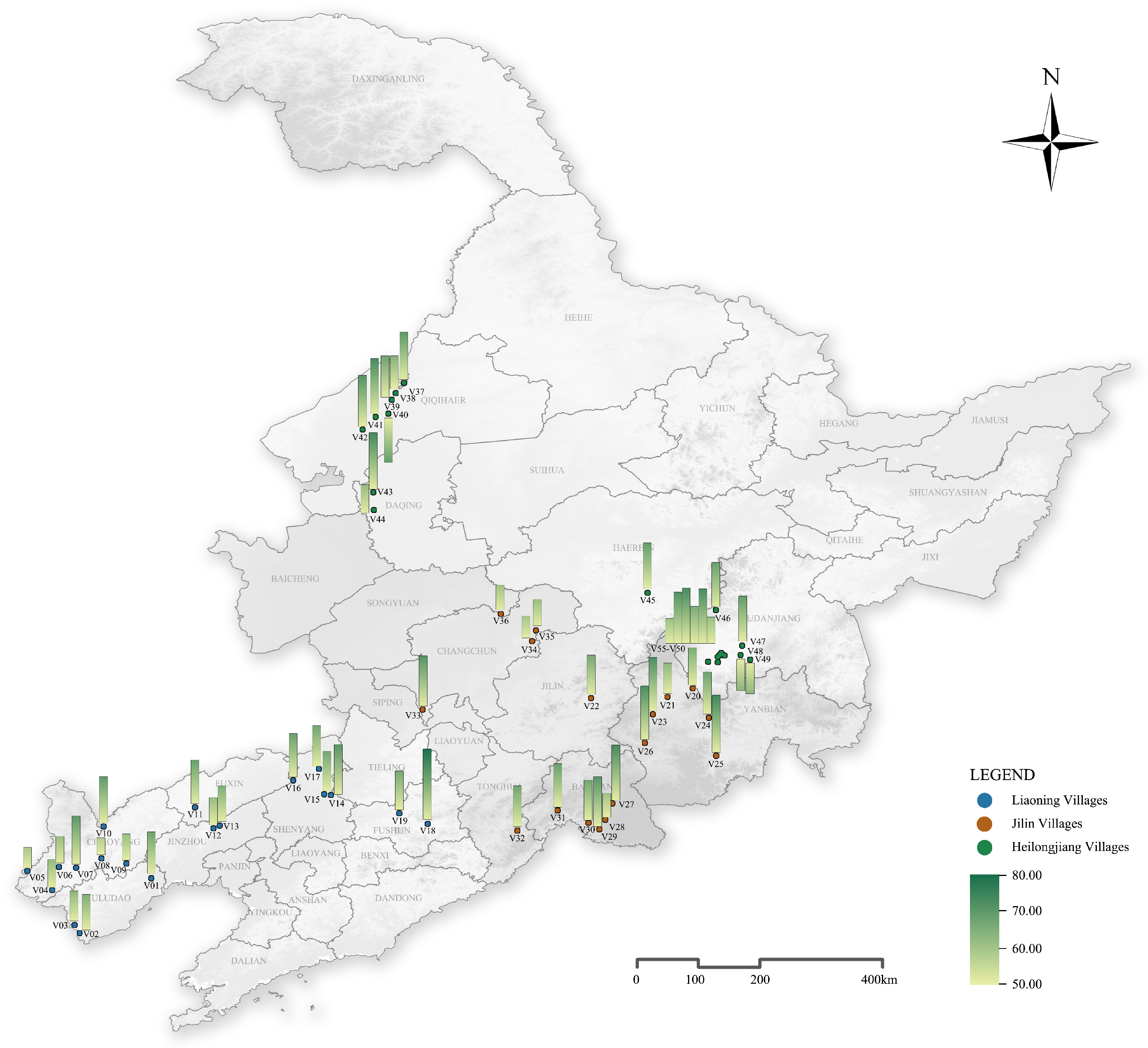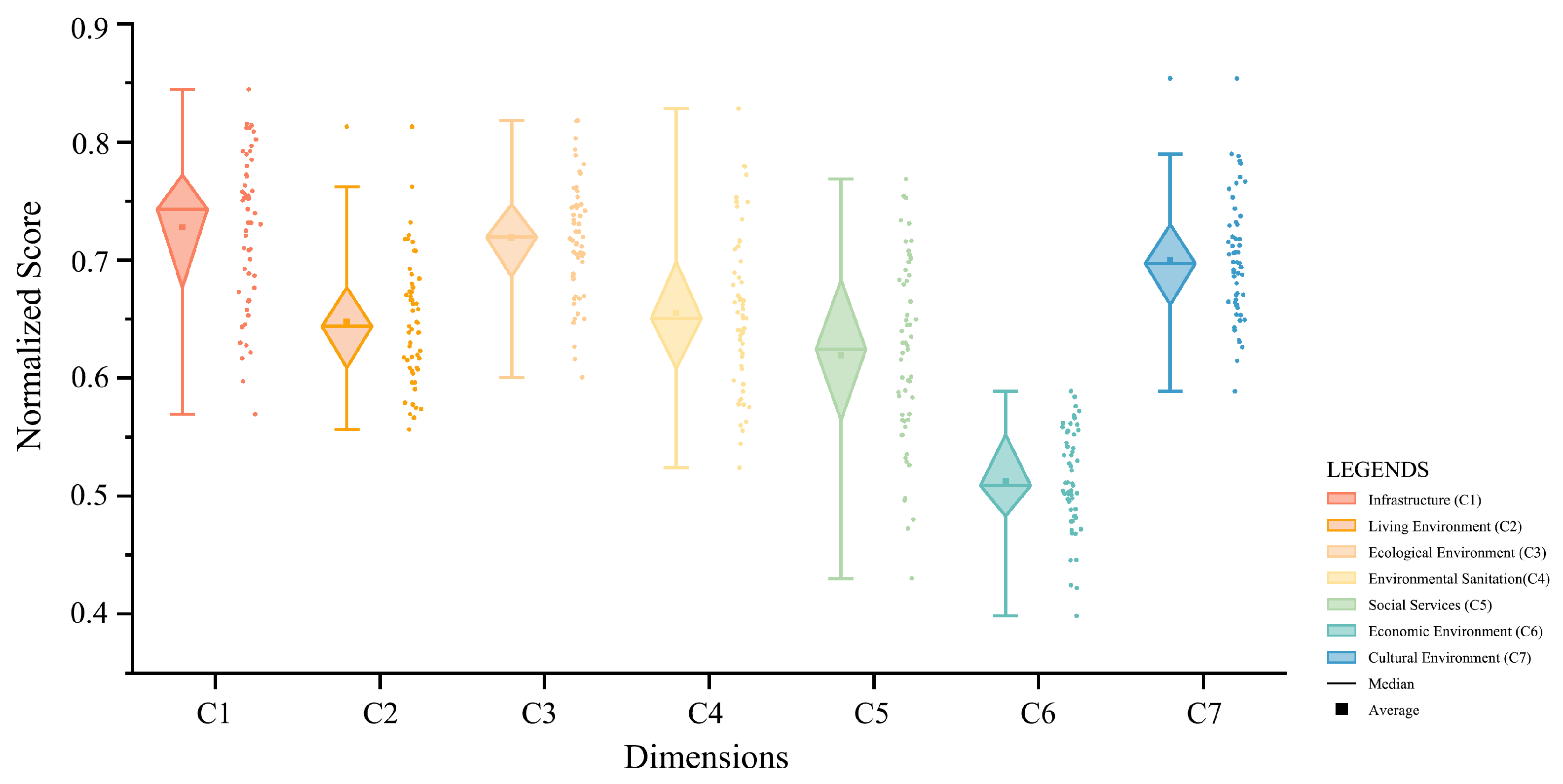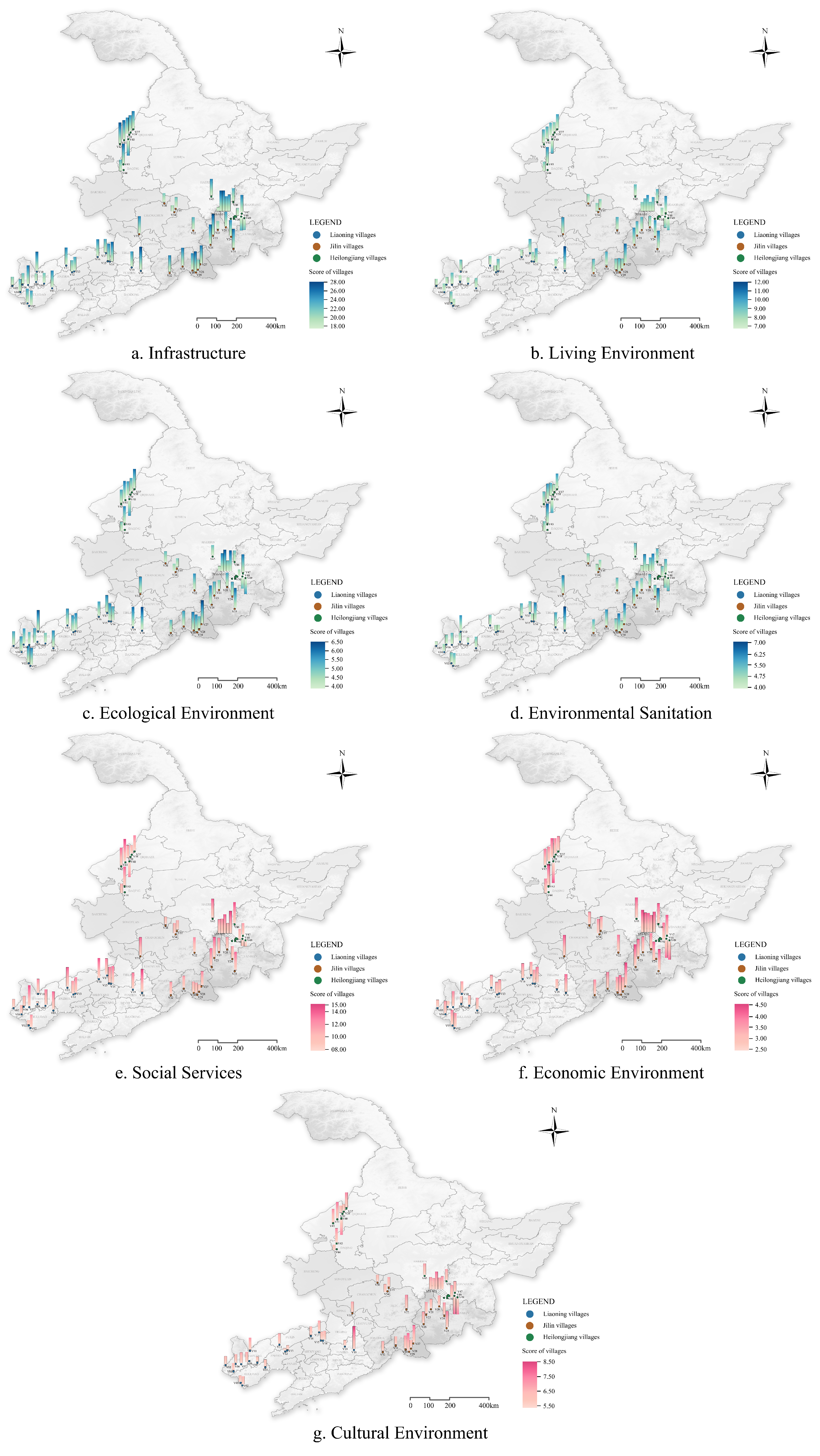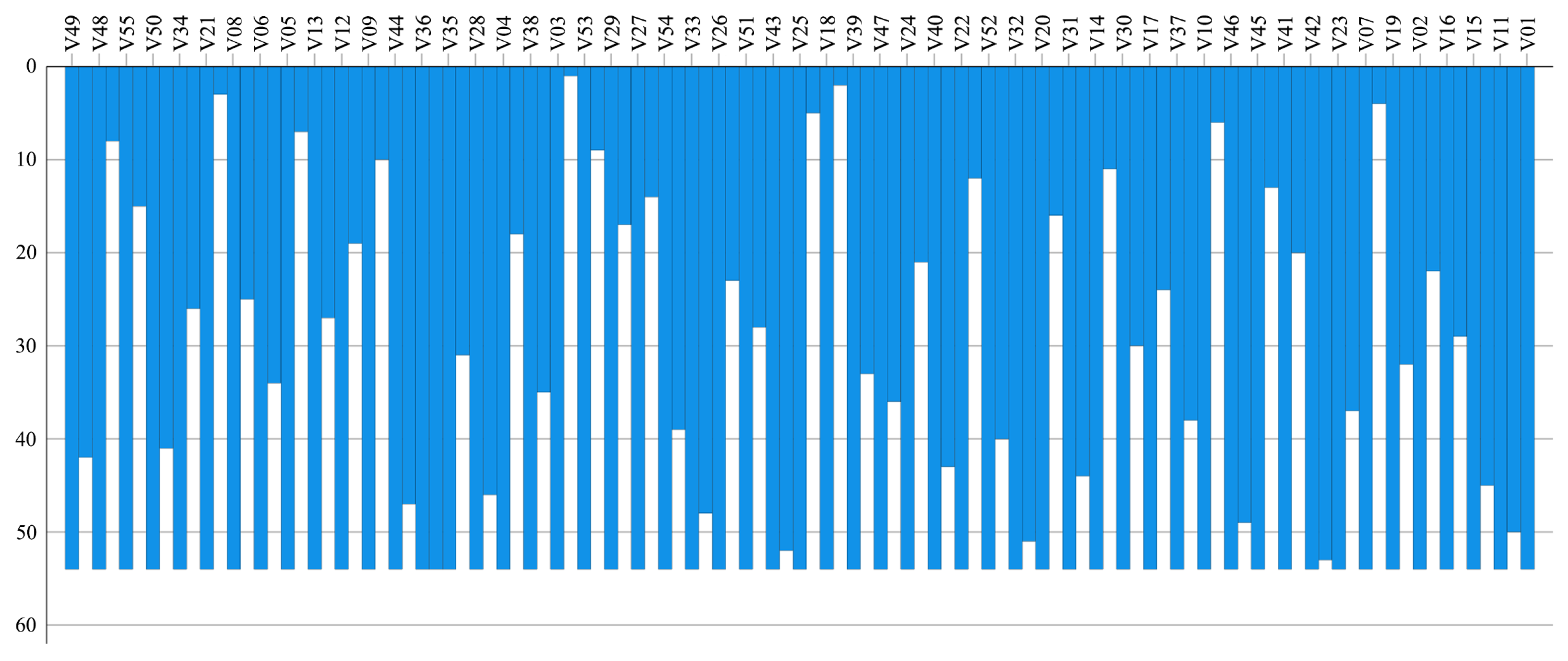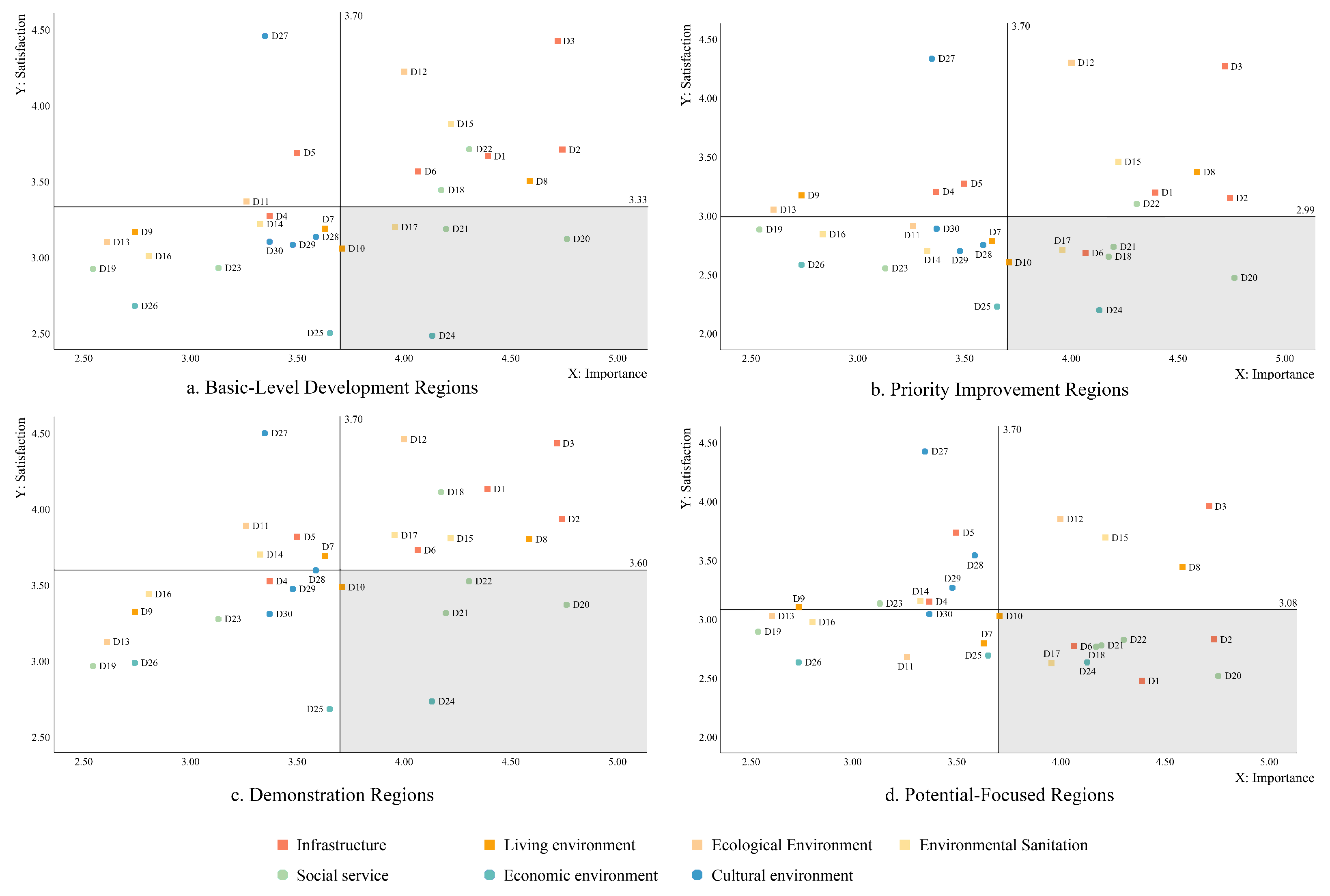1. Introduction
Since the early 20th century, theories of human settlements have gradually evolved and become more refined. From Howard’s “Garden City” model and Geddes’ idea of “regional planning” [
1,
2] to Mumford’s emphasis on ecological and humanistic values [
3] and further to Doxiadis’ “Ekistics” and Wu’s localization of the “science of human settlements” [
4,
5], the development of this field has increasingly emphasized systematization and human-centeredness. In recent years, driven by China’s rural revitalization policies and the global SDG agenda, scholars have evaluated rural livability and villagers’ satisfaction using multidimensional indicator systems [
6,
7]. SDG-oriented frameworks have provided operational pathways to integrate SDG targets into the measurement and diagnosis of rural human settlement sustainability [
8,
9]. Building on these advances, the application of human settlement theories to traditional villages has become increasingly urgent [
10]. However, current planning and construction practices for traditional villages in China remain largely uniform, prioritizing “hardware” improvements such as infrastructure while neglecting villagers’ cultural needs and spatial heterogeneity [
11,
12]. This mismatch between policy supply and actual demand highlights the need for a villager-centered evaluation system for traditional village human settlements (TVHSs).
Currently, most evaluations of human settlements adopt a macroscale approach, focusing on regional differences and development trends through methods such as statistical analyses [
13], spatial pattern studies [
14], and indicator systems guided by the Sustainable Development Goals (SDGs) [
8]. Although effective in revealing regional disparities, this approach fails to capture villagers’ perceptions and diverse needs at the microscale [
15], especially in traditional villages with unique spatial structures and cultural characteristics [
16]. As a result, macrolevel analyses provide limited guidance for village-level optimization. On the other hand, subjective satisfaction-based evaluations can partly reflect villagers’ perceptions, but they generally lack in-depth considerations of importance perceptions regarding indicators, remaining focused on overall satisfaction [
17]. This limitation weakens the policy relevance of findings and hinders the formulation of precise and effective optimization strategies for villages.
Within existing TVHS evaluation systems, the cultural environment dimension is often overlooked or underweighted [
18,
19]. However, collective memory and cultural identity are key psychological foundations of villagers’ quality of life and environmental satisfaction. The continuity of historical settings and cultural traditions fosters pride and shared memory, enabling traditional villages to maintain relatively high levels of subjective satisfaction through place attachment and identity, even when material conditions are less favorable [
20]. This omission weakens the explanatory power of evaluation results and highlights the need to incorporate cultural indicators into TVHS evaluation.
Furthermore, the single-method nature of existing evaluations further reduces the interpretability and applicability of research outcomes. Subjective expert-based weighting methods, including the analytic hierarchy process (AHP), its variants [
21,
22], and the best–worst method (BWM) [
23], can incorporate expert experience but are prone to personal bias and lack consistency guarantees [
24,
25]. Alternatively, objective statistical methods, such as entropy [
26], CRITIC [
27], and principal component analysis (PCA) [
28], provide greater objectivity, but they fail to capture the substantive importance of indicators [
29]. Therefore, a critical methodological challenge is the integration of villagers’ subjective importance scores with expert knowledge to develop a multi-method fusion weighting system that ensures both stability and interpretability.
To address the above theoretical and methodological gaps, this study takes Northeast China as a representative region for empirical analyses. Traditional villages in this area face a unique set of challenges, including rapid population aging, limited infrastructure, and harsh winter conditions, which have resulted in clear mismatches between policy goals and villagers’ real needs. These factors render the region both challenging and representative, providing a realistic context for testing whether the proposed evaluation model can effectively capture satisfaction patterns and guide improvement strategies under complex conditions. By focusing on this region, this study directly addresses the research gap by developing an integrated approach to evaluate satisfaction levels, identify village types, and propose context-specific optimization strategies for TVHSs.
Accordingly, 55 traditional villages in Northeast China were selected for empirical analyses. From a microscale perspective, a comprehensive evaluation framework is constructed that covers both the hard (infrastructure, living environment, ecological environment, and environmental sanitation) and soft environments (social services, economic environment, and cultural environment). Theoretically, cultural landscape theory is integrated with human settlement theory to provide a coherent framework for assessing the cultural dimension of traditional villages. Methodologically, villagers’ importance perceptions are combined with expert-based weighting, employing AHP, CRITIC, and grey relational analysis (GRA) to construct a hierarchical weighting structure. Ward’s clustering is applied to classify villages, while the importance–satisfaction (IS) model and the obstacle degree model are used to identify and prioritize key optimization indicators. Mediation analysis is conducted to test potential mechanism effects, providing additional explanatory support. Finally, this study proposes localized optimization strategies that integrate spatial patterns, landscape management, and cultural heritage [
30].
Against this background, this study pursues three objectives:
- (1)
To construct a villager-centered satisfaction evaluation framework integrating both hard and soft environment dimensions;
- (2)
To identify satisfaction typologies and spatial differentiation among villages in Northeast China;
- (3)
To propose differentiated and feasible optimization strategies for cold-region settlements.
To achieve these aims, the following research questions are addressed:
- RQ1:
What are the overall and dimensional satisfaction levels of TVHS, and how can these levels be quantitatively measured and validated using the constructed indicator system and multi-method weighting approach?
- RQ2:
What typological categories and spatial distribution patterns emerge from the evaluation results?
- RQ3:
Which indicators constitute major obstacles to satisfaction, and how should improvement priorities be formulated?
The remainder of this article is organized as follows:
Section 2 develops the theoretical framework and conceptual foundations of this study;
Section 3 introduces the data and research methods;
Section 4 presents the empirical results;
Section 5 discusses the findings and policy implications;
Section 6 concludes with limitations and future directions.
Overall, this study contributes systematic innovation through the integration of theoretical frameworks, the inclusion of villagers’ participation in indicator construction, the application of multiple weighting methods, the testing of mechanism effects, and the linkage of spatial typology with optimization strategies. It addresses the weak emphasis on cultural dimensions in existing systems, enhances the interpretive rigor and policy relevance of results, and provides theoretical support and practical pathways for the precise implementation of the rural revitalization strategy. At the same time, beyond the Chinese context, the framework proposed in this study offers transferable methodological insights for evaluating and optimizing TVHSs in other regional and cultural settings.
4. Results and Analysis
4.1. Overall Satisfaction Evaluation Results
Based on the established evaluation index system and scoring method, satisfaction scores were calculated for 55 traditional villages in Northeast China (
Table 4). The overall average was 66.99 with a median of 67.25, a standard deviation of 4.93, and a coefficient of variation of 7.35%, suggesting relatively balanced satisfaction and controllable inter-village differences. Most villages scored between 60 and 70, while 3 fell below 60 and 16 exceeded 70, accounting for 5.45% and 29.09%, respectively. Hetuala village achieved the highest score (80.04), and Sanjia village exhibited the lowest score (57.18), mainly due to its location in a mountainous area with poor infrastructure and extremely inconvenient transportation, which severely restricts villagers’ mobility and access to essential services. In addition, the village’s limited industrial base and weak economic vitality further contribute to its low satisfaction level.
From a provincial perspective, the average scores of Liaoning, Jilin, and Heilongjiang were 65.85, 67.18, and 67.95, respectively. Liaoning lagged slightly below the overall mean and exhibited larger disparities due to uneven development and resource allocation. Jilin was moderate, with some higher-scoring villages benefiting from ethnic culture and tourism. Heilongjiang showed smaller disparities, supported by concentrated village distribution and balanced infrastructure and ecological services.
Spatially, satisfaction presented a clear “northeast–southwest” declining pattern (
Figure 4). Villages in the northeast (V37–V44) and southeast (V20–V32 and V45–V55) had higher averages of 68.98 and 67.88, driven by ecological resources, tourism, and policy support. In contrast, western Liaoning (V01–V13) and northern Jilin (V34–V36) scored much lower (63.92 and 60.29), reflecting weak infrastructure, limited economies, and poor accessibility (see
Table 5 for village codes).
4.2. Satisfaction Evaluation Results of Each Dimension
To enable cross-dimensional comparisons, the scores of each dimension were normalized to a 0–1 scale using full-score normalization and presented in a boxplot (
Figure 5). The spatial distribution maps of each dimension were constructed using the original scores to reflect differences in absolute levels (
Figure 6). Furthermore, to identify villages that performed significantly well or poorly in each dimension, villages were classified as high-scoring or low-scoring according to whether their values exceeded or fell below the mean ± 1 standard deviation for each dimension.
Overall, the central positions of dimensions C1 and C3 are relatively high, with both mean and median values exceeding 0.7, indicating that most villages demonstrate good construction and maintenance in these two aspects. The mean values of C2, C4, and C5 are close, at 0.65, 0.66, and 0.62, respectively. However, C4 and C5 exhibit greater dispersion, suggesting more pronounced inter-village differences. C6 exhibited the weakest performance, with a mean of only 0.51 and a long lower tail, indicating that the economic environment is the main shortcoming of traditional villages and that some villages have significantly low values in this dimension. In contrast, C7 exhibits an upper-middle level of satisfaction, with a concentrated distribution and low variability, reflecting relatively balanced cultural resources among the villages.
Infrastructure (
Figure 6a) records an average score of 24.11. Villages scoring above the high threshold (26.23) include V14, V18, V23, V26, V29, V41, V42, V43, V53, and V54, which are mainly distributed in the central–eastern part of Heilongjiang and parts of Jilin. Conversely, villages below the low threshold (21.99), such as V05, V08, V09, V21, V28, V34, V35, V36, V50, and V55, are primarily concentrated in western Liaoning and southwestern Jilin. The overall spatial pattern aligns with the distribution trend with respect to overall satisfaction.
Living environment (
Figure 6b) records an average score of 9.30. Villages exceeding the high threshold (10.06) include V18, V24, V25, V26, V27, V33, V43, V47, and V53, which are mainly concentrated in southern Jilin. In contrast, villages below the low threshold (8.54), such as V02, V05, V06, V08, V09, V12, V16, and V19, are all located within Liaoning Province. Significant provincial differences are observed, with Jilin and Heilongjiang recording higher average scores (9.59 and 9.45, respectively) compared to Liaoning (8.89).
Ecological environment (
Figure 6c) records an average score of 5.31. The five highest-scoring villages are V27, V18, V53, V51, and V10, all of which are significantly above the high threshold (5.67). In contrast, villages including V09, V21, V34, V35, V36, V44, V45, V46, V50, V52, and V55 fall below the low threshold (4.95). Among them, V34, V35, and V36 form a contiguous low-value cluster in spatial distributions. These results are primarily attributed to industrial pollution and the relatively weak ecological awareness of villagers.
Environmental sanitation (
Figure 6d) records an average score of 5.56. Villages V14, V18, V25, V27, V29, V33, V43, V51, and V54 exceed the high threshold (6.13), with high-scoring areas mainly concentrated in eastern Jilin, where some ethnic minority villages have relatively well-established public sanitation management systems. In contrast, villages scoring below the low threshold (4.99) are primarily located in Liaoning, with the five lowest-scoring villages being V05, V09, V13, V55, and V12. Common issues include low frequencies of daily cleaning and a shortage of dedicated or part-time sanitation staff.
Social services (
Figure 6e) record an average score of 12.21. Villages V07, V11, V16, V18, V23, V41, V43, V45, V46, V51, and V53 all score above 13.75. In contrast, villages V03, V04, V05, V08, V28, V36, V38, V48, and V49 fall below 10.67. Villages with lower scores are primarily located in areas with pronounced mountainous terrain, where terrain and accessibility constraints limit infrastructure development and service provision.
Economic environment (
Figure 6f) records an average score of 3.66. Villages V25, V26, V27, V33, V40, V43, V45, V46, V51, V54, and V55 score above 3.97 and are mostly distributed in the southeastern region. In contrast, villages V05, V06, V08, V09, V10, V12, and V19 fall below 3.36, all of which are located in Liaoning Province. Overall, the pattern exhibits a decline from northeast to southwest, and this is closely associated with the limited per capita arable land, a single industrial structure, and insufficient employment opportunities.
Cultural environment (
Figure 6g) records an average score of 6.84. V18 exhibited 8.35, which is significantly higher than others, and it mainly benefited from intact folk traditions, active cultural activities, and tourism development. Overall, the cultural environment shows relatively small inter-village differences, with the high and low thresholds being 7.35 and 6.34, respectively. Low-scoring villages, represented by V09, V12, V13, V19, and V44, are primarily constrained by dispersed settlement patterns, disrupted cultural inheritance, and weak activity platforms.
4.3. Village Classification
By conducting cluster analysis on the satisfaction data of 55 traditional villages and incorporating the average scores across seven dimensions (
Figure 7), the villages can be classified into four categories: basic-level development regions; priority improvement regions; demonstration regions; and potential-focused regions. According to the results of statistical significance tests, the differences among these categories are highly significant across all dimensions (
p < 0.001), while the relatively small within-group standard deviations indicate internal homogeneity, demonstrating strong explanatory power and practical value. More radar charts were plotted based on the percentage-standardized scores of each dimension (
Figure 8) to visually illustrate the performance characteristics of each category across different dimensions.
The basic-level development regions include V01, V02, V07, V10, V11, V14, V15, V16, V17, V19, V20, V22, V23, V24, V30, V31, V32, V37, V39, V40, V41, V42, V45, V46, V47, and V52, totaling 26 villages. Villages in this category demonstrate an overall satisfaction level that is moderately high, with relatively balanced performance across dimensions and scores in infrastructure and social services close to those of the demonstration regions. Although no prominent shortcomings are evident, the economic and cultural environment dimensions still have room for improvement, indicating potential for further development.
The priority improvement regions include V03, V04, V05, V06, V08, V09, V12, V13, V28, V35, V36, V38, and V44, totaling 13 villages. Villages in this category generally record low satisfaction levels across all dimensions, with the weakest performance in the economic environment and social services, reflecting relatively lagging basic conditions. Some of these villages are located in remote or mountainous areas, facing inconvenient transportation and underdeveloped infrastructure. At the same time, they suffer from population outflow and accelerated aging, resulting in insufficient development vitality. Consequently, they constitute the key targets for subsequent intervention and improvement.
Demonstration regions include V18, V25, V26, V27, V29, V51, V53, and V54, totaling 10 villages. Villages in this category rank among the highest across all dimensions, with particularly outstanding advantages in infrastructure, environmental sanitation, and social services, reflecting a highly balanced development profile. Most of these villages have well-developed infrastructure and external transportation conditions, with some designated as key construction villages or tourism development villages, with strong development foundations.
Potential-focused regions include V21, V34, V48, V49, V50, and V55, totaling six villages. Villages in this category perform relatively well in the cultural environment dimension but score lower in infrastructure, economic environment, and social services, placing their overall satisfaction level at a lower-middle level. These villages possess certain historical and cultural resources or regional characteristics but lack sufficient development support conditions. Therefore, it is necessary to improve the basic environment while also leveraging their cultural potential.
4.4. Identification of Key Optimization Indicators for TVHS Satisfaction
In this study, the IS model was applied to generate IS matrices for the four village classifications (
Figure 9). The results show that there are significant differences in the distribution of indicators in the IS two-dimensional space among village classifications. According to the research design, this section primarily focused on the key indicators located in the fourth quadrant:
Basic-Level Development Regions: The fourth-quadrant indicators were mainly concentrated in the social services dimension, revealing persistent weaknesses in basic services and livelihood security. The specific indicators included D10, D17, D20, D21, and D24.
Priority Improvement Regions: The fourth-quadrant indicators covered a broad range, reflecting multidimensional improvement needs that require coordinated advancement. The specific indicators included D6, D10, D17, D18, D20, D21, and D24.
Demonstration Regions: Although the overall satisfaction level was relatively high, there remained room for “marginal improvement” in public services and environmental details. The specific indicators included D10, D20, D21, D22, and D24.
Potential-Focused Regions: The deficiencies were the most widespread, spanning multiple dimensions, such as infrastructure, economic environment, and social services. The specific indicators included D1, D2, D6, D10, D17, D18, D20, D21, D22, and D24.
4.5. Prioritization of Key Optimization Indicators for TVHS Satisfaction
After completing the obstacle degree calculations for all indicators, this study identified the set of fourth-quadrant indicators based on the IS model, extracted their corresponding obstacle degrees, and ranked them within each village classification (
Figure 10). The results showed that the primary obstacle factors differed across village classifications, highlighting the key directions for type-specific governance. The specific ranking results were as follows: basic-level development regions: D20 > D10 > D21 > D24 > D17; priority improvement regions: D6 > D20 > D10 > D18 > D21 > D24 > D17; demonstration regions: D20 > D21 > D10 > D24 > D22; potential-focused regions: D1 > D2 > D6 > D20 > D18 > D21 > D10 > D22 > D17 > D24.
A cross-classification comparison showed that D10, D20, D21, and D24 consistently appeared in the fourth quadrant across all four village classifications, and D17 also occurred frequently, forming common weaknesses shared across classifications. The main reasons were as follows: D10 was affected by the cold winters in Northeast China, and most existing toilets lacked proper ventilation and frost-proof design, which resulted in poor user experience. D17 was limited by insufficient funding and personnel for maintenance, resulting in low cleaning frequency and poor sanitation conditions. D20 was constrained by the low spatial accessibility of medical resources and the limited capacity of primary healthcare facilities, resulting in inconvenient medical services, slow emergency response, and high referral rates from local clinics. D21 was influenced by school mergers, which increased commuting distances while school bus services remained insufficient, extending students’ commuting times and increasing parents’ transport burdens. Finally, D24 was shaped by a single industrial structure and the limited capacity of non-agricultural employment and emerging industries, while labor outflow and human capital constraints further hindered villagers’ income growth. Overall, these issues collectively resulted in a persistent gap between the importance and satisfaction of the related indicators, and they also kept these indicators at the top of the obstacle degree rankings over the long term.
4.6. Mediation Analysis of Dimensional Relationships for TVHS Satisfaction
Based on the above findings, the priority optimization indicators were mainly identified in C1, C2, and C4, which were merged into the “hard environment” (H) to capture the material conditions that could be directly improved through engineering and maintenance. Simultaneously, C5 and C6 were combined into the “Socio-economic environment” (M), which was used to depict the “physical input–functional provision–satisfaction” transmission chain. In contrast, C3 and C7 were more closely related to long-term ecological quality and cultural identity, which were difficult to influence in the short term through service provision. Therefore, they were included separately as control variables in the mechanism tests to reduce omitted-variable bias and enhance model robustness.
The results showed that H had a significant direct effect on overall satisfaction (S) (
), and it exerted a partial mediating effect through M. The indirect effect was approximately 0.20–0.22 (bootstrap 95% CI: 0.12–0.34), accounting for about 25% of the total effect. Further tests confirmed that the mediating effect remained significant when either C3 or C7 was used as a control variable, indicating that the conclusion does not depend on a specific control setting (
Table 6).
To strengthen robustness, SEM was also used for validation. Due to the limited sample size, the SEM fit indices were unsatisfactory, as RMSEA and SRMR substantially exceeded the recommended thresholds of 0.05 and 0.06 [
53]. However, the path coefficients were consistent with the PROCESS results (
Table 7), which provides additional support for the robustness of the conclusion.
4.7. Optimization Strategies for TVHS Satisfaction
Based on the combined results of the IS model and the obstacle degree model, 10 indicators (D1, D2, D6, D10, D17, D18, D20, D21, D22, and D24) were finally identified as requiring priority optimization. Since some indicators appeared repeatedly across different classifications, to avoid redundancy, the following section consolidates the repeatedly occurring indicators by dimension and proposes general optimization strategies that are applicable to all village classifications.
Road Infrastructure Optimization (D1): Damaged roads should be resurfaced and widened, with priority given to ensuring smooth connections along primary village–town corridors. Drainage ditches and guardrails should also be improved to enhance accessibility and safety during rainy and snowy seasons. Where conditions permit, permeable pavement may be adopted to improve durability and environmental adaptability.
Water Supply Enhancement (D2): Aging pipelines should be thoroughly inspected and replaced, with supporting purification and disinfection facilities installed. In areas with seasonal fluctuations in water sources, storage facilities should be constructed, and online water quality monitoring and early warning systems introduced. A sound pricing and maintenance mechanism should also be established to ensure long-term and stable supply.
Smart Lighting Improvement (D6): Solar streetlights should be promptly maintained and upgraded, with smart lighting added at key locations. Intelligent control systems should be applied to enhance energy efficiency and ease of maintenance, thereby improving nighttime safety and life quality [
54].
Toilet Facility Upgrade (D10): Flush or ecological toilets should be constructed in public activity areas and integrated with landscaping elements (such as greenery and ecological partition walls) to ensure harmony with traditional village styles [
55]. Health education and standardized usage training should be provided in parallel to improve facility usability and user satisfaction.
Environmental Sanitation Co-Governance (D17): Sanitation staff and equipment, as well as cleaning frequency during peak periods, should be improved. At the same time, a grid-based responsibility system with villager participation should be implemented to ensure a normalized and long-term mechanism for environmental sanitation management.
Cultural Landscape Empowerment (D18): Cultural plazas, village murals, and folk exhibition spaces should be introduced as landscape nodes based on functional zoning. The support of historical and cultural interpretation should be provided to strengthen cultural imagery and identity, thereby promoting the revitalization and transmission of traditional culture [
56].
Telemedicine Coverage (D20): Village-level clinics should be constructed or expanded and equipped with basic medical staff, while regular free clinics should be organized. Internet-based telemedicine consultation and follow-up platforms should be established to ensure that basic healthcare needs can be addressed locally and to enhance the accessibility of medical services [
57,
58].
Education Service Enhancement (D21): Student transportation should be optimized through improved school bus services, bus stops, and safety measures. Educational infrastructure should be upgraded, and resources for books and cultural activities should be expanded to promote a higher quality of rural education and support students’ overall development [
59].
Consumer Service Enhancement (D22): Convenience stores and farmers’ markets should be established or upgraded in central areas and highly accessible areas to ensure the supply of essential goods and medicines. Rural logistics stations and smart lockers should be introduced in cooperation with e-commerce and delivery companies to improve distribution efficiency and accessibility. Fairs should be organized on a regular basis to diversify consumption channels and enhance the vitality of public spaces.
Cultural Tourism and Industrial Income Growth (D24): Characteristic rural tourism should be developed on the basis of local history and culture, through approaches such as open-air museums and cultural trails. These initiatives provide a low-cost and highly participatory method for showcasing traditional architecture and folk culture, thereby enhancing tourism potential, promoting cultural preservation, and strengthening villagers’ sense of identity [
60,
61]. Orchards and specialty agricultural products should be developed into specialty picking and eco-experience activities, while e-commerce platforms and cooperatives should be leveraged to expand income channels and promote economic diversification [
62]
5. Discussion
5.1. Theoretical Integration and Alignment with Research Objectives
This study’s findings align closely with the theoretical framework that integrates human settlement and cultural landscape perspectives and directly address the three research objectives.
For RQ1, the empirical results show that both hard and soft environment factors exert direct and indirect effects on villagers’ satisfaction. This finding is consistent with human settlement theory, which emphasizes that the interaction between the hard and soft environments jointly shapes residents’ satisfaction. Although the indicators of the cultural environment dimension contribute less to overall satisfaction, their inclusion underscores the significance of cultural landscape theory, particularly in traditional villages, where cultural continuity and local identity are essential for sustaining long-term satisfaction within their unique settlement contexts.
For RQ2, the village typologies identified through clustering reveal how satisfaction patterns vary across spatial and contextual conditions, demonstrating that settlement development follows region-specific adaptation rather than uniform growth paths.
For RQ3, the IS and obstacle degree analyses identify key weaknesses that reveal where mismatches between policy supply and villagers’ daily needs are most pronounced.
Taken together, these findings fulfill this study’s initial objectives with respect to evaluation, classification, and optimization and reinforce the theoretical proposition that sustainable satisfaction improvement depends on the integrated advancement of hard and soft environment dimensions.
5.2. Comparative Analysis with Previous Research
In recent years, TVHS research has expanded, with satisfaction evaluation used to gauge how policy delivery matches villagers’ perceptions and cultural continuity. Existing frameworks mostly rely on human settlement theories, the SDGs, and the rural revitalization strategy [
8,
34,
63]. This study extends these frameworks by incorporating cultural landscape theory and operationalizing a cultural environment dimension, rendering the system more suited to the specificities of traditional villages. Empirically, satisfaction in Northeast China remains dominated by infrastructure and public services, while cultural indicators do not yet appear among priority items. This reflects the combined influence of the development stage, cold-region infrastructure constraints, and a policy bias toward “hardware.”
The overall satisfaction score for TVHS in Northeast China is 66.99. Compared with results for Northwest China [
21] and for urban and rural residents in Northeast China [
15], this value is slightly lower. Possible reasons for this phenomenon are the harsh winters, which intensify negative perceptions of heating, water, and road reliability, and the limited economic vitality and service accessibility of traditional villages. The obstacle dimensions identified here are consistent with prior studies [
17,
33,
37], supporting the evaluation’s reliability. By contrast, satisfaction scores are much higher than macrolevel quality scores derived from statistical data [
34], suggesting that such macroassessments do not necessarily align with villagers’ subjective satisfaction. Under severe climatic and developmental constraints, villagers emphasize usability, accessibility, and maintenance experience over mere facility presence, creating a “mismatch” with objective quality assessments.
Methodologically, unlike previous studies that rely mainly on subjective expert judgment (AHP, BWM), we adopt a hierarchical weighting scheme—AHP for dimensions and CRITIC–GRA with villager and expert scores for indicators—thereby avoiding the pairwise-comparison burden and consistency risks for non-professional respondents [
47]. External validation against a direct-scoring baseline shows close agreement (average relative deviation: 7.83%; Spearman
), indicating high consistency (
Figure 11). These results suggest that the objective weighting of subjective inputs is feasible and robust for TVHS satisfaction, reduces subjective bias, and more sensitively captures villagers’ preferences.
5.3. Policy Implications and Implementation Principles
Building on empirical results, mediation analyses further confirmed that material improvements increase overall satisfaction both directly and indirectly through social services and economic opportunities. This indicates that infrastructure and environmental upgrades must be integrated with service delivery and economic support to secure lasting gains. Accordingly, we summarize indicator-level strategies into cross-cutting principles applicable across different village contexts:
Phased and Typological Pathways:
Short-term (0–2 years) efforts should address high-obstacle indicators in the hard environment for each village classification. Medium-term (3–5 years) priorities should shift to social services and economic opportunities, while long-term (5–10 years) strategies should emphasize landscape management and cultural activities, making culture a source of resilience. These measures should be implemented through small-scale, continuous improvements with villager participation to ensure the everyday usability of public spaces and infrastructure.
Coordinated Governance and Cost Constraints:
Funding streams for village protection, settlement improvement, and cultural tourism should be pooled within county or city planning frameworks. Operation and maintenance budgets and clear performance indicators—such as outage duration, winter accessibility, and post-harvest cleanliness—should be specified at the project approval stage to avoid a “build but neglect” pattern. In cold regions, durable and energy-efficient materials should be prioritized, with decisions based on life-cycle costs rather than lowest bids, supported by seasonal maintenance records.
Monitoring Feedback and Adaptive Management:
Annual monitoring should cover three bundles of indicators: satisfaction, objective quality, and operation and maintenance. Adjustments should then be guided by IS quadrants and obstacle thresholds to prevent performance decline after one-off interventions and to improve the efficiency of resource allocation.
5.4. Regional and Global Implications
Traditional villages in Northeast China exhibit typical characteristics of cold climates, aging populations, and weak infrastructure. These challenges are not unique to China but are also widespread among cold-region settlements worldwide, such as those in Hokkaido, Japan; Northern and Eastern Europe; and the Russian Far East. In Hokkaido, studies have documented how demographic shrinkage and harsh winters result in farmland abandonment, housing deterioration, and service contraction [
64]. Recent research on the shrinking city of Yubari further emphasizes that effective adaptation in cold regions requires re-prioritizing social infrastructure and community capacity rather than relying solely on physical upgrades [
65]. Similar structural challenges are observed in European rural regions. An econometric analysis of 78 municipalities in Northern Spain demonstrated that proximity to transport and social infrastructures significantly reduces rural depopulation risk, whereas limited accessibility accelerates population loss [
66]. These findings align with our conclusion that improvements in infrastructure are most effective when coordinated with social services and economic opportunities, which together enhance residents’ satisfaction and settlement sustainability.
Given these shared challenges, the analytical framework developed in this study serves as a reference for evaluating and optimizing TVHS in other regions. The indicator system established in this research integrates both hard and soft environment dimensions, systematically revealing the structural characteristics of villagers’ satisfaction and providing a foundation for comprehensive evaluations across different settlement types. Building on this framework, the typological optimization strategies proposed in this study offer differentiated improvement pathways for various settlements, providing practical insights for resource allocation and planning decisions in regions with similar climatic and cultural contexts. Furthermore, this study reveals the interactive mechanisms among the physical environment, social services, and economic opportunities, demonstrating that improvements in infrastructure can indirectly enhance overall satisfaction through social and economic pathways. Together, these components constitute a comprehensive and adaptable analytical framework that supports satisfaction-based evaluation and targeted optimization while also offering methodological guidance for sustainable rural development in cold and resource-constrained regions.
5.5. Limitations and Future Research Directions
This study has four main limitations. First, although the questionnaire was designed to capture villagers’ overall perceptions, the sample exhibited certain demographic imbalances (such as age, education, and occupation), which may have resulted in variations that were not fully addressed. These imbalances partly reflect the demographic reality of traditional villages in Northeast China, where population aging and youth migration are common, but they may still limit how broadly the findings apply to all villagers. In addition, although the number of valid questionnaires was kept consistent across villages to ensure comparability, this approach may not fully reflect differences in population size, potentially introducing slight biases in aggregated satisfaction levels. Second, although the cultural dimension was constructed based on cultural landscape theory, the indicators remained relatively generalized and failed to fully capture the distinctive cultural and historical attributes of traditional villages in Northeast China. These villages are characterized by diverse ethnic groups with different cultural carriers and inheritance patterns, but such variations were not sufficiently reflected in the current indicator system, which may have limited the explanatory power of the cultural dimension in identifying the key drivers of cultural satisfaction. In addition, the concept of collective memory, although implicitly reflected through indicators such as folk heritage and richness of cultural activities, was not explicitly operationalized, which may have limited the analytical depth of the cultural dimension from the psychological perspective. Third, although this study attempted to determine indicator weights by integrating the perceived importance of both villagers and experts, differences in their perceptions may have influenced the results. Villagers tended to place greater emphasis on aspects closely related to daily life, such as infrastructure and social services, which resulted in relatively low weights for cultural environment indicators in the overall evaluation system. Finally, the economic environment dimension mainly focuses on general income indicators, such as per capita disposable income, Engel’s coefficient, and collective income. It does not explicitly include characteristic economic activities that are particularly relevant to traditional villages in Northeast China. The absence of these indicators may limit the comprehensiveness of the economic evaluation and reduce its ability to reflect local economic vitality.
Future research could proceed in four main directions. First, to better account for sample heterogeneity, future studies could incorporate multilevel or hierarchical linear models (HLMs) that statistically separate individual-level (villager) and village-level effects and conduct subgroup analyses according to age, education, and occupation to capture differentiated satisfaction patterns. Furthermore, future surveys could adjust the number of questionnaires in each village proportionally to its population size to enhance representativeness and reduce sampling bias. Longitudinal data collection or panel modeling could further reveal how demographic and contextual factors dynamically influence satisfaction over time, providing more robust inference and avoiding aggregation bias. Second, future research could strengthen the cultural dimension by incorporating both tangible and intangible elements that reflect the diverse cultural and historical contexts of traditional villages in Northeast China. For example, indicators related to traditional dwellings, handicrafts, languages, and customs can be included to better represent the cultural characteristics of different ethnic groups and their modes of inheritance. Integrating survey data with spatial and textual information would help build a more comprehensive evidence base and improve the explanatory power of the cultural dimension in understanding satisfaction differences among villages. Furthermore, as the core value of traditional villages lies in their irreplaceable cultural uniqueness, capturing how collective memory shapes villagers’ sense of belonging and satisfaction is essential for deepening the understanding of the cultural dimension and enhancing the explanatory power of future evaluation frameworks. Future research could explicitly operationalize the concept of collective memory by incorporating measurable aspects such as the preservation and use of historical spaces, the continuity of traditional festivals and folk activities, and villagers’ sense of cultural identity and pride. Third, future research could further optimize the balance between expert and villager perspectives. Increasing the relative influence of expert judgments, particularly for culturally related indicators, would help better reflect the significance of cultural landscape integrity and its contribution to overall satisfaction while maintaining the representativeness of villagers’ perceptions. Finally, the economic environment dimension could be expanded by incorporating indicators that capture characteristic local economic activities—such as income from cultural tourism and the sale of specialty agricultural products—to more comprehensively reflect local economic vitality and development potential. Including these indicators in future frameworks could provide a clearer understanding of how local economic diversification contributes to improving villagers’ income and sustaining the long-term vitality of traditional villages.
